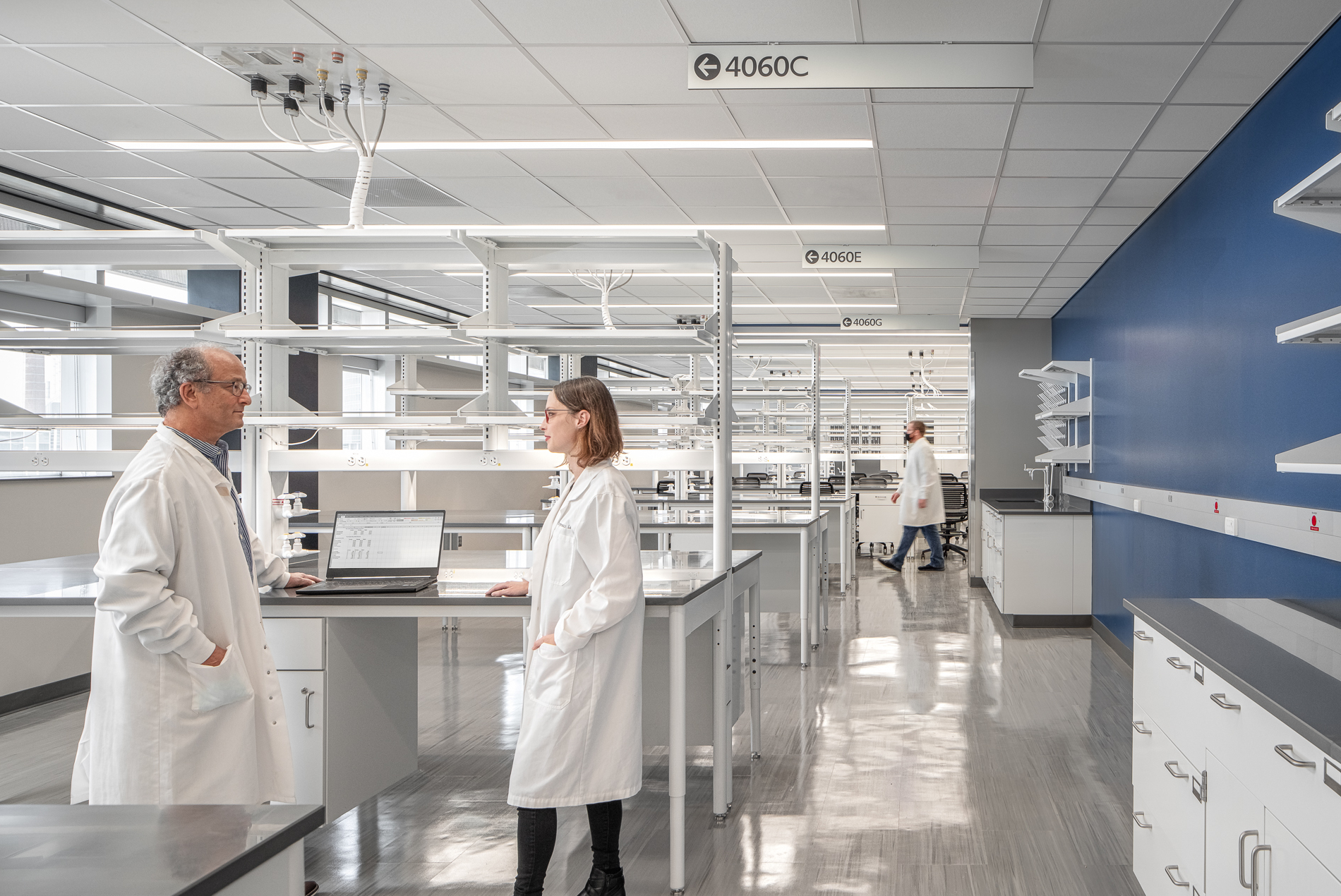New scientific opportunities are creating demand for more and better laboratory space. For academic and teaching institutions, this demand often leads to renovating and expanding existing research labs to accommodate new practices and technology.
For private organizations, demand has many companies exploring ways to convert existing office buildings and underutilized lab spaces into hubs for scientific research. The same is true in the public sector, where governments and health agencies seek opportunities to modernize and expand their research capabilities as quickly and inexpensively as possible.
A renovated lab can cost half as much as a similar brand-new building. Converting an existing building into lab space (adaptive reuse) can also be faster and less expensive than ground-up projects. Renovations and adaptive reuse have the additional benefit of being more environmentally friendly, as these projects generally do not require replacing carbon-heavy concrete and steel structural systems.
Still, lab renovations and conversions are not without their own challenges. Institutions considering a modernization or adaptive reuse of an existing lab facility should weigh the following factors before committing to a project.

Checklist for Renewal
1. Understanding the Existing Facility: Lack of quality design or construction documents is a common challenge in renovation and conversion projects. Gathering a good understanding of existing conditions of the facility—its floor-to-floor height, floor loading, structural system design and age, mechanical and system conditions—is a must before embarking on renovation projects.
The age and condition of existing materials may trigger the need for abatement and remediation, which can add to expense and time for the project. Starting with a feasibility study or facility conditions assessment study will help ensure the success of the project.
HOK’s adaptive reuse design repurposed a long-vacant warehouse in St. Louis’ Cortex Innovation Community into a multi-tenant biotech lab and office space.
2. Risk of the Unknown: Laser scanning, testing and historical research can help project teams anticipate most—but not all—the construction challenges that will reveal themselves during a lab renovation or adaptive reuse conversion. Even with a thorough feasibility study, organizations should anticipate surprises once demolition and construction begin. They should build contingencies for solving those challenges into the project scope and budget.
Emory University hired HOK to renovate its 1980s-era biochemistry labs to support collaboration, flexibility, and wellness.
3. Code Compliance: An existing building, particularly one built decades ago, is probably not in line with current life safety, energy and accessibility codes. Updating an existing building to meet these new codes may not always be economically feasible.
Additionally, institutions must consider how a renovation or conversion might trigger code-mandated upgrades in parts of the building that are not part of the lab space. For example, the expansion of a lab may also require additional amenity spaces and restrooms to be upgraded for code compliance.
Learn how HOK transformed an office park into a start-of-the-art research campus.
4. MEP Infrastructure: Lab buildings can require far more mechanical, electrical and plumbing infrastructure than what is found in other building types. Updating an existing facility for new lab space may require cutting holes in the floor to support additional ventilation shaft space and installing new rooftop air handlers.
Project teams should pay particular attention to rooftop load capacity and floor-to-floor ceiling height to ensure a building has the structural integrity and space to support additional ventilation equipment and ductwork. Other MEP considerations for renovated or converted lab space can include backup power (generators) to ensure tests continue during power outages and installing gas lines and additional plumbing to support multiple research needs.
The National Institutes of Health (NIH) hired HOK to upgrade an existing lab into an Interim Intravenous Admixture Unit (IVAU).
5. Specialized Spaces: Beyond MEP considerations, a lab renovation or adaptive reuse may need other infrastructure improvements. Organizations may begin by analyzing floor movement within the existing building, as lab equipment often requires strict vibration control.
Labs may also require positive or negative air flow that can be difficult to achieve if an existing facility is not tightly sealed. Column-to-column dimension is another factor to consider, particularly when it comes to the arrangement of lab modules that are typically 10.5 to 11 feet long. More complex labs may also require clean construction protocols that add costs and environmental monitoring systems to ensure operational safety.
Final Thoughts
Lab renovations and conversions offer many advantages over ground-up facilities. They can be significantly less expensive to build and faster to complete. They don’t require the acquisition of new property and tend to be more environmentally friendly than new construction projects.
Yet not all existing labs and buildings are ideal candidates for renovation and/or adaptive reuse. Owners and developers must begin with a thorough understanding of a facility’s existing condition and build contingencies into the schedule in case unexpected challenges emerge during demolition.
Experienced design teams can help owners eliminate many of these unknowns while also ensuring that a new lab has the infrastructure and flexibility to support current and future codes, MEP requirements and specialized research needs.
Have additional questions about a lab renovation or conversion or want more information on the topics and case studies presented here? Contact any of the authors below.
Chirag Mistry leads HOK’s Science + Technology practice in the Southeast. Based in Atlanta, his expertise includes the design of engineering labs, complex bioscience and biomedical research labs, and BSL-3 facilities.
Emily Fowlkes is a senior lab planner in HOK’s San Francisco studio. Her expertise includes programming, planning and designing lab environments for clients in the fields of corporate life sciences, public health, academic research, forensics and electronics.
Aaron Altman is director of operations in HOK’s Washington, D.C., studio where he manages projects for multiple federal clients. Aaron’s design specialties include forensic labs, cleanrooms, cancer research and radio-pharmacy spaces.
Related reading: Designing Developer-Led Lab Projects to Raise a City’s Science Profile